Dinosaur Appearances and Anatomy
1/68
Earn XP
Description and Tags
Lesson 1 Definitions
Name | Mastery | Learn | Test | Matching | Spaced |
|---|
No study sessions yet.
69 Terms
Chevrons
Bones underneath the caudal vertebrae; they protect a large blood and nerve channel and provide support for tail muscles.
Caudal Vertebrae
Vertebrae in the tail.
Sacrum
To further increase the strength of the hips, the sacral vertebrae are also fused with one another and form a single solid bone structure.
Sacral Vertebrae
Vertebrae in the hips
Because the pelvic bones in terrestrial vertebrates serve a solid anchors for powerful leg muscles, the pelvic bones are fused to the sacral vertebrae.
Palaeontology
The study of all prehistoric life.
Fossil
Any preserved evidence left behind by a prehistoric organism.
Adaptations
Traits that have evolved because they serve specific functions.
Vertebrates
Animals that have two special kinds of skeletal adaptations: skulls and vertebrae.
Invertebrates
Animals that lack vertebrae, including insects, spiders, snails, clams, jellyfish, and worms.
Saurischians
Dinosaurs that share an evolutionary ancestor with a pubis that extended downwards and forwards, towards the ribcage.
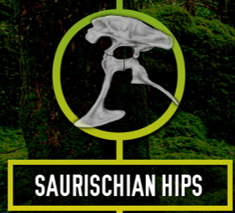
Ornithischians
Dinosaurs that share an evolutionary ancestor that had both a special beak-forming bone in the upper jaw (called the predentary) and a pubis that extended downwards and backwards, towards the tail.

Fenestrae
Large openings in dinosaur skulls that provide extra room for muscle attachment and reduce weight.
Tetrapods
A group of vertebrates that evolved from an ancient ancestor with four feet and four limbs.
Most tetrapods still have four feet and limbs, although some, like humans, have hands instead of front feet and some, like snakes, have lost their limbs altogether.
Osteoderms
Bones that develop within the skin, common in animal armor.
Some stegosaurs also have osteoderm spikes on their backs and over their shoulder.
Keratin
A tough but flexible material that covers scales, hair, feathers, fingernails, and the outside of claws, beaks, and horns.
Dental batteries
Collectively formed large chewing surfaces in dinosaurs, especially herbivores.
Cervical vertebrae
Vertebrae in the neck, adapted to support the weight of the head.
Pelvic girdle
The bony structure that connects the hindlimbs to the vertebral column, or hip bones.
Humerus
The largest bone in the forelimb, located between the shoulder and elbow.
Sinosauropteryx
A small theropod dinosaur known for having fossilized feathers.
Yutyrannus
The largest known feathered dinosaur, a tyrannosauroid.

Gastralia
Small ribs positioned across a dinosaur’s underbelly, underneath the ribcage.
“belly ribs”
Limb Girdles
Structures that attach limbs to the body, providing support and mobility.
Pectoral Girdle
The skeletal structure that connects the forelimbs to the axial skeleton, also called “the shoulder girdle.”
Scapula
The shoulder blade associated with the pectoral girdle, allowing for limb attachment and movement; the largest bone in each side of the pectoral girdle.
Ilium
The uppermost part of the hip bone, forming a crucial component of the pelvic girdle, providing attachment for various muscles and support for the lower limbs.
it is to the ilium that the sacral vertebrae are fused
Pubis
The bone located below the ilium and in front of the ischium, nearer the belly.
Ischium
The bone located below the ilium and behind the pubis, nearer the tail.
Acetabulum
The depression or (as in dinosaurs) the hole in the pelvic girdle into which the hind limb articulates.
Nares (singular: naris)
The external openings of the nasal cavity in vertebrates, primarily involved in respiration and the sense of smell.
Orbits
The bony cavities in the skull that hold and protect the eyes.
Laterotemporal Fenestrae
The openings in the skull located behind the eyes, allowing for the attachment of jaw muscles.
Supratemporal Fenestrae
The openings in the skull located above the orbits on top of the skull, facilitating muscle attachment and reducing skull weight.
Antorbital Fenestrae
The openings in the skull located in front of the orbits and behind the naris; the function of which is unclear.
Centrum
A vertebra that has a spool- or disk-shaped body.
Neural Arch
Located above the centrum, it covers the neural canal.
Neural Canal
The opening in each vertebra, through which the spinal nerves run.
Vertebral processes
Provide attachment surfaces for muscles and sometimes provide articulation surfaces for ribs.
Transverse Processes
A common type of vertebral process, which extend from the lateral sides of the vertebrae.
Spinous Processes
A common type of vertebral process, which extend upwards from the neural arch.
Dorsal Vertebrae
The vertebrae in the back; often have tall spinous processes and large rib articulation surfaces.
Radius
The bone located between the elbow and the wrist, parallel to the ulna
In most tetrapods, it is the thinner of the two bones.
Ulna
The bone located between the elbow and the wrist, parallel to the radius.
Carpals
The bones in the wrist.
Metacarpals
The bones between the wrist and the fingers.
Phalanges
Finger and toe bones.
Femur
The bone located between the hip and knee; the largest none in the hindlimb.
Fibula
The bone located between the knee and the ankle, parallel to the tibia.
Tibia
The bone located between the knee and the ankle.
Tarsals
The bones in the ankle.
Metatarsals
The bones between the ankle and toes.
Sauropodomorphs
Large herbivores with elongated necks and relatively small heads.
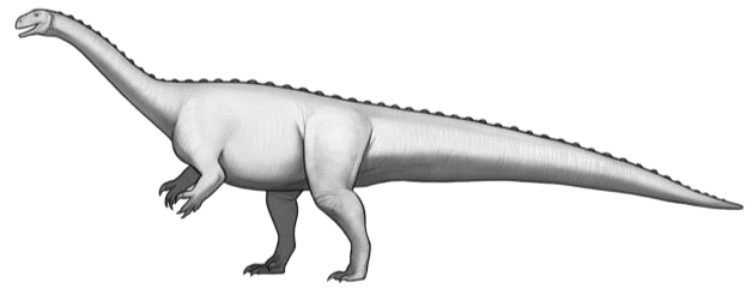
Prosauropods
An early group of sauropodomorphs and the first group of large-bodied herbivorous dinosaurs to evolve.
Sauropods
A later group of sauropodomorphs
Many attained truly gigantic size, and the group includes the largest animals to ever walk the earth.
They stood on four robust and column-like legs.
Their vertebrae (particularly the cervical vertebrae) are filled with complex air sacks, which helped to reduce weight.
Their teeth are usually simple and peg-like.
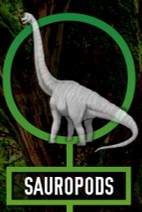
Theropods
Bipedal saurischian dinosaurs that shared a carnivorous ancestor.
Many were carnivorous and have serrated blade-like teeth and sharp hooked claws, but some were herbivorous and a few lack teeth altogether.
Birds are a dinosaur of this type. (The only group of dinosaurs that is not completely extinct.
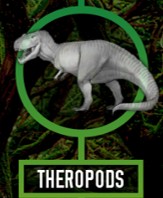
Ornithopods
A wide range of dinosaurs that lack armor and that either walked bipedally all the time or assumed a bipedal stance when running.
Part of the Ornithischian dinosaurs
Many are small antelope-sized dinosaurs, but some, like the iguanodons and hadrosaurs, grew to be multi-ton giants.
Iguanodons
Large ornithopods with a spike-shaped claw on each hand.
Hadrosaurs
A group of large ornithopods, are the famous “duckbilled dinosaurs.”
They evolved late in the history of dinosaurs, but were highly successful.
Some have elaborate boney crests, and they all have strikingly large beaks in the front of their mouths and dense, tightly packed rows of small teeth in the rear of their mouths.
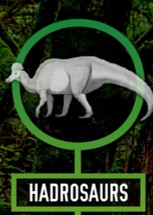
Pachycephalosaurs
Bipedal with short arms, unusually stout and strong tails, and armored skulls.
Some have thick, doomed skull roofs and backwards-pointing horns.
They have sharp conical teeth in the front of their mouths, behind their beaks, and leaf-shaped teeth in the rear.
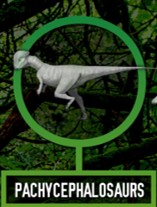
Ceratopsians
A group that evolved late in the history of dinosaurs.
They have large parrot-like beaks and skulls that are greatly expanded in the rear.
In most of them, this rear skull expansion is taken to an extreme and large boney frill, or neck shield, is present.
Many have large horns and also possess dental batteries.
Triceratops is easily the most famous of its kind and is one of the largest.
Most large members of the group were quadrupedal and have short tails.
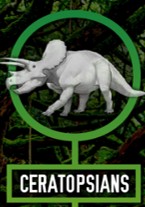
Stegosaurs
A group of quadrupedal dinosaurs with rows of projecting osteoderm plates down their backs and long osteoderm spikes on their tails.
Some also have osteoderm spikes on their backs and over their shoulders.
Their front limbs are much shorter than their hind limbs.
They were probably not fast runners, but they could probably pivot quickly and could rear up and stand on their hind legs.
Their heads are small relative to their bodies and their snouts are narrow.
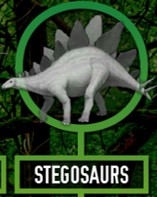
Osteoderms
Bones that develop within the skin and are a common component of animal armor.
Ankylosaurs
The most heavily armored of all dinosaurs.
They are quadrupedal with short legs and wide ribcages.
The backs and skulls of most of them are covered in spikey protective osteoderms.
Some also have large osteoderms on the ends of their tails, forming a mace or “tail club.”
Unlike their relatives, the stegosaurs, most have short snouts and broader, rounded beaks.
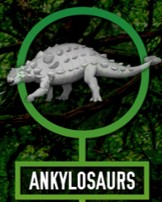
Integument
A tough outer protective layer or body covering.
Psittacosaurus
A specimen of the early ceratopsian, they preserved unusual long, stiff, bristle-like structures on its tail, but it was unclear if these were related to the feathers of birds and theropods.
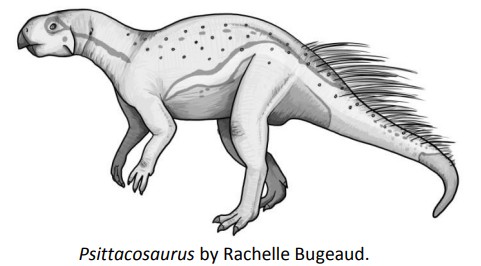
Tianyulong
A very primitive ornithischian from China, was described, and this ornithischian was covered in long filaments over most of its body.
Kulindadromeus
An early and primitive ornithischian dinosaur from Russia, and it preserves not just simple, bristle-like filaments like those found in Psittacosaurus and Tianyulong, but branching, feather-line structures as well.
Melanosomes
Pigment cells within a feather.
Studies of modern birds have shown that feather color is influenced by the shape and arrangement of these pigment cells.
Scipionyx
A small theropod dinosaur from Italy.
One specimen of this dinosaur actually preserves the mineralized remains of the trachea (windpipe) in the throat, and the intestines.
A red smudge in the fount of the belly region might represent the decayed remains of the heart, liver, or spleen.
Some of the muscles were also preserved, as were the keratinous sheaths over the claws.